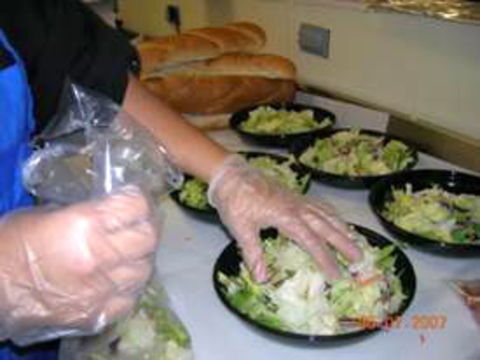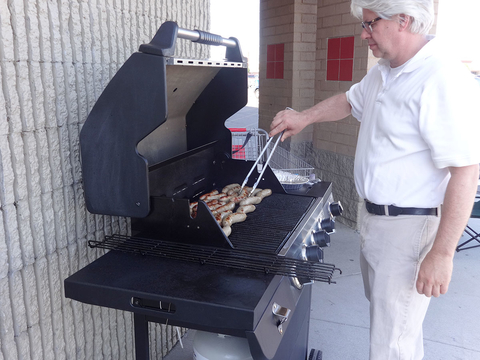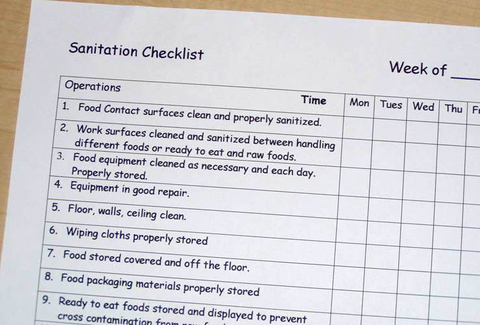One of the first steps in planning a food event is to select a menu and recipes. Keep in mind that cooking for 150 people is certainly different from cooking for a family of four.
Selecting a menu
The food you prepare and serve must be safe. Not only will these tips help you serve safe food but will preserve the quality too.
Who are you serving? Children under the age of 4, the elderly and people with weakened immune systems are at greater risk for food borne illness. Certain foods are less prone to bacteria than others.
- Dry foods or those high in sugar are almost always safe.
- Breads, rolls, cakes (without cream filling), fresh whole fruits (keep cold if cut up), vegetables, cookies and crackers are safe.
- High-protein foods like meat, milk and dishes containing egg are potentially hazardous.
- Roast beef, chicken breast and turkey have a shorter refrigerator life than processed meats or cold cuts. Properly wrap and freeze deli meats that won’t be used within two to four days.
- Low-acid foods like potatoes, rice, custards, puddings, gravies and stuffing should be served with extreme caution.
- Single-serving, prepackaged portions are the safest.
- Consider offering sandwiches, cookies or other food items in individual, food-grade plastic bags or plastic wrap.
- If cooking foods beforehand, such as turkey, ham, chicken, and vegetable or pasta salads, chill all ingredients before mixing them together. This means chilling hard-cooked eggs, pasta, meat, etc.
- Obtain foods from reliable sources.
- Do not serve home canned foods.
Meal variety
Plan for contrast in food color, texture, shape, temperature and flavor to provide variety in the group meal.
Recipes
- Use standardized quantity recipes when preparing food for 25 or more people. Recipes in reliable quantity cookbooks are typically designed for 25, 50 or 100 portions. Do you have the right sized equipment for the amount of food you plan to prepare? Use recipes designed for 25 or more people.
- Small quantity recipes are out of proportion when multiplied. This is especially true in baked products and those that call for a thickening agent.
- If you want to use a family-size recipe, make a single batch 3 or 4 times to get the quantity you need.
Recipe Yield - Quantity recipes show yield and serving size: “Yield 50 1-cup servings.” This means that 50 people can be served from that recipe if the servings are approximately 1 cup each, and if only one serving per person is planned. Plan to have enough food to serve without excessive leftovers.
Equipment and space available
What equipment is available for you to use?
- Is oven space limited? If so, roast meat, baked potatoes and hot apple pies are definitely out of the question.
- Limited refrigerator space may determine the type of salad to be served.
- Does the group have access to large pots and pans? If so, be sure to allow plenty of time for food to cook in large quantities, especially on top of the stove. It takes much longer for 10 quarts of water to boil than it does 2 quarts. If large pots and pans are not available, be sure to have enough smaller sizes on hand.
- If preparing the meal on-site, think through each step of the preparation. List equipment and space needed and check what is available.
Location
Will the meal be served in a meeting hall, at the fairgrounds or on the street at a festival? These different locations create the need for careful thought in menu selection, preparation and serving.
- Are there facilities available for proper washing and sanitizing of cooking utensils and dishes?
- Are separate hand-washing facilities available for volunteers?
- Do you need a food license for your event?
Time and labor needed in preparation
- A few experienced people can manage a simple meal, but the more complex the menu, the more time and help will be needed in preparation, service and cleanup.
- Allow extra time if this is a first-time event or there are several new volunteers. It is always better to have some free time before an event, than be rushed into serving or having the food not done on time.
- If ice cream, refrigerated salads or other foods needing cold storage are on the menu, plan ahead for adequate refrigerator or freezer space. Don’t wait until the last minute to try to solve a space problem. You may create a time management and food safety problem.
- Allow plenty of volunteers to get the job done right. Train volunteers and assign a ‘person-in-charge’ of the food event.
Type of service
Consider the location, needs of the event and what the volunteers can handle when making a decision on type of service. A successful buffet meal calls for food that people can easily serve themselves; however, in this type of service, portion control is lost. Family-style service requires extra serving pieces and food that is easily passed. Portion control may also be a factor in this type of service. Another possibility is the plate meal, where dishes are served to each person at the event.
Occasion and group
Menus should be tailored to fit the group and the occasion - from a formal banquet to a family night supper. Keep in mind the taste and preferences of the group to be served and whether it is the main meal of the day for them. Another factor to consider is special dietary concerns including food allergies. Some items can be served on the side to allow the guests a choice.
Food for Fifty. B.B. West, S.G. Shugart and M.F. Wilson. New York: John Wiley and Sons, Inc.
Reviewed in 2021





